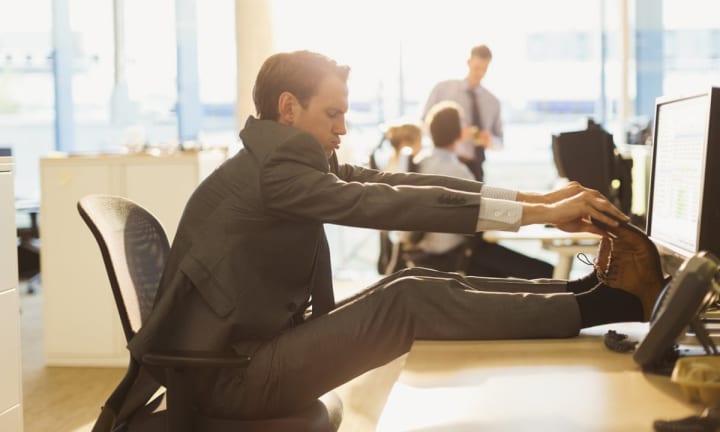What happens to the body when sitting for too long every day?
Sitting too long (too much sitting) every day, over time, can affect your health in many ways.

What happens to the body when sitting for too long every day?
Sitting for too long can cause a number of negative side effects for your body. Without movement, muscles become tense, joints become stiffer, and metabolism and circulation slow down. These changes can lead to various health problems and will become more serious over time, as your sitting time increases.
Sitting too much makes leg muscles inactive. Over time, this causes muscles to weaken and fatigue quickly when performing physical activities. Not being active enough and sitting too long also increase the risk of sarcopenia or muscle loss.
As strength in the legs and glutes gradually decreases, daily activities such as getting up from a chair, walking, and going up and down stairs may become more difficult; especially for older people when the natural aging process occurs in parallel.

Lack of exercise will cause muscles to become increasingly tight, this is especially true of the hip flexors - part of the core, this is the muscle group that runs from the spine to the femur and helps the pelvis to move. you are in line. The hip flexor muscle consists of 3 muscles, 2 of which form the Iliacus (iliac muscle) and the Psoas (lumbar muscle) or also known as Iliopsoas (iliopsoas muscle).
Tighter hips can cause limitations in mobility and increase stress on the lower back.
Sitting for too long also increases the pressure between the discs in the lumbar spine of the lower back, leading to pain, increasing the risk of bulging and herniated discs as well as sciatica complications .
Stiffness in the neck and shoulders is also a common complication seen in people who have the habit of sitting in one place for long periods of time. Staying in one position for too long, especially with poor posture, can strain the upper body.
Sitting for long periods of time in a hunched position can also cause restrictions in the movement of the diaphragm, making it more difficult for air to enter and leave the lungs. Over time, this can contribute to restrictive airway disease .

Lack of physical activity causes a person's metabolism to slow down, leading to the body being less efficient at breaking down food for energy and having a greater risk of storing fat, thereby leads to obesity.
5. Changes in blood flow
Because your muscles aren't working while sitting, blood flow to your legs is reduced. This in turn can impair the ability of the veins and lymphatic system to function properly, causing fluid to build up, leading to leg swelling and poor circulation.
Sitting too long and not being physically active can slow down the entire body including the mind. In other words, this leads to cognitive changes that can affect a person's memory and ability to think logically.
In addition, a sedentary lifestyle also increases the risk of depression and other mood disorders.
Osteoporosis is also a bone and joint condition that easily develops in people who sit for long periods of time and do not have exercise habits, causing bones to become weaker and more brittle.
Sitting too long also leads to muscle imbalances, increasing the risk of injury when performing daily activities.

Because sitting too long will impair circulation, providing less oxygen to the blood vessels in the legs. This decrease in oxygen narrows blood vessels, while lack of exercise increases fibrinogen, a protein that causes blood to clot.
These risk factors increase the likelihood of blood clots in the legs, also known as deep vein thrombosis (DVT).
Reduced blood flow can also have long-term consequences on circulation and can lead to atherosclerosis or hardening of the arteries due to plaque buildup.
This can increase the risk of developing conditions such as heart disease and heart attack due to restricted blood flow to the heart.
Arteriosclerosis due to poor circulation that occurs when sitting for too long can also lead to increased blood pressure.
Blood is less able to flow through hardened arteries, causing blood pressure to increase through constricted arteries. This leads to hypertension (high blood pressure).

The longer the sitting time, the stronger the negative changes in metabolism, including increased blood sugar levels due to muscle inactivity, preventing sugar from being "transported" out of the blood to be converted into sugar. energy.
In the long term, when the amount of sugar in the blood accumulates enough to cause blood sugar levels to always be high, it will develop into diabetes as well as many other dangerous diabetes complications such as kidney, cardiovascular, diabetic eye complications, and complications. diabetic neuropathy,...
Regular rest and activity can also help improve blood flow to the legs, which can help reduce swelling, stiffness, and muscle tension. It is important to note that resting after sitting for too long should incorporate some type of physical activity instead of just standing for the sake of standing in one place doing nothing.
Neck stretches, chest and shoulder stretches, hip back stretches or hamstring stretches are some of the recommended on-the-spot activities when you often sit for long periods of time. Finally, when sitting in one place for a long time, you also need to make sure you sit in the correct posture to reduce stress on your muscles and joints while sitting. Adjust your chair and desk to suit the correct sitting posture, helping to limit back and neck pain. Use a chair with a back cushion or back pillow to support your spine. Adjust the computer screen to a straight line of sight, no need to bend down or tilt up when sitting and using it.
Talk to your doctor and see your doctor if you have swelling or increased pain in your legs or lower back when sitting for long periods of time. The pain can be more severe, accompanied by cramps and hot swelling in the calves, which can warn of blood clots causing many negative consequences and require special attention to intervene as soon as possible.
About the Creator
Ken aquariums
Telling stories my heart needs to tell <3 life is a journey, not a competition
If you like what you read, feel free to leave a tip,I would love some feedback
https://sites.google.com/view/hk-decor/trang-ch%E1%BB%A7
Enjoyed the story? Support the Creator.
Subscribe for free to receive all their stories in your feed. You could also pledge your support or give them a one-off tip, letting them know you appreciate their work.






Comments
There are no comments for this story
Be the first to respond and start the conversation.